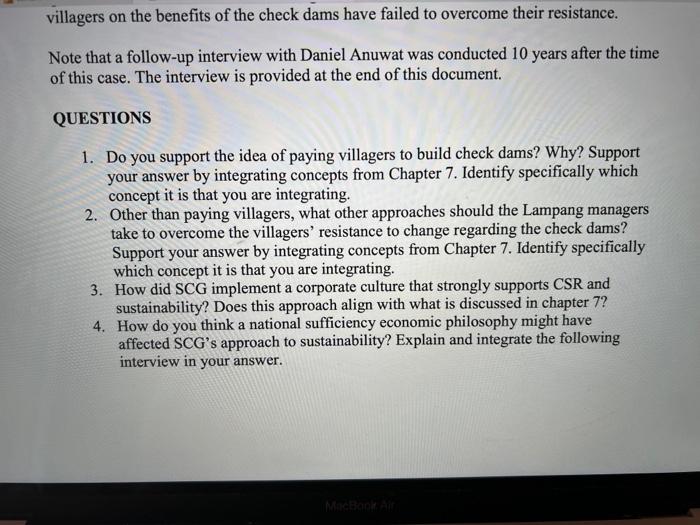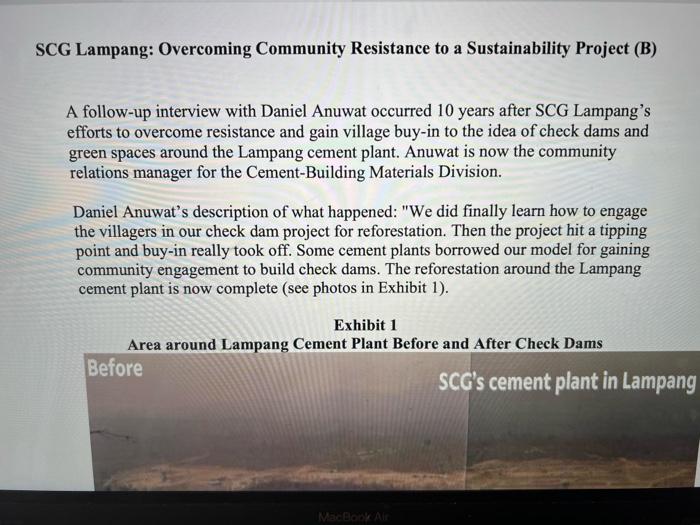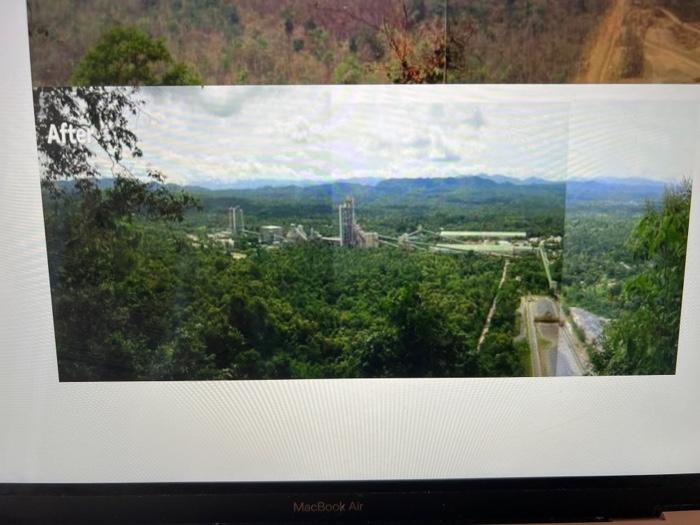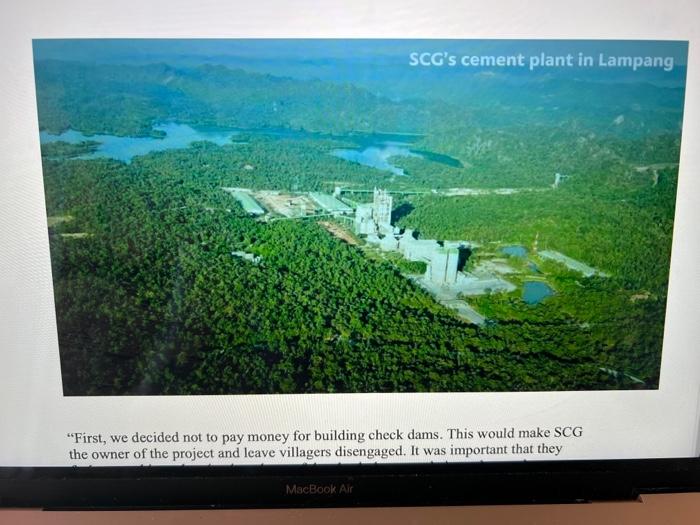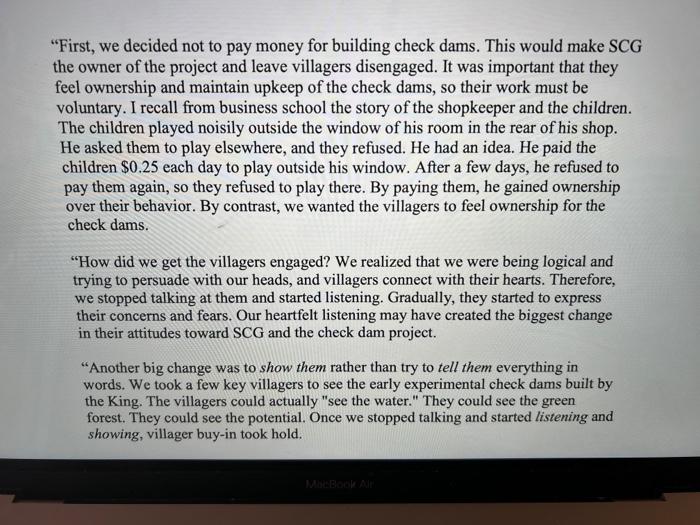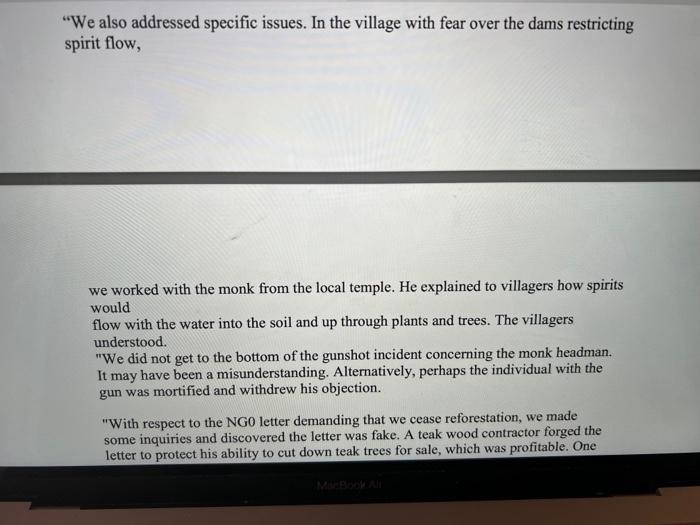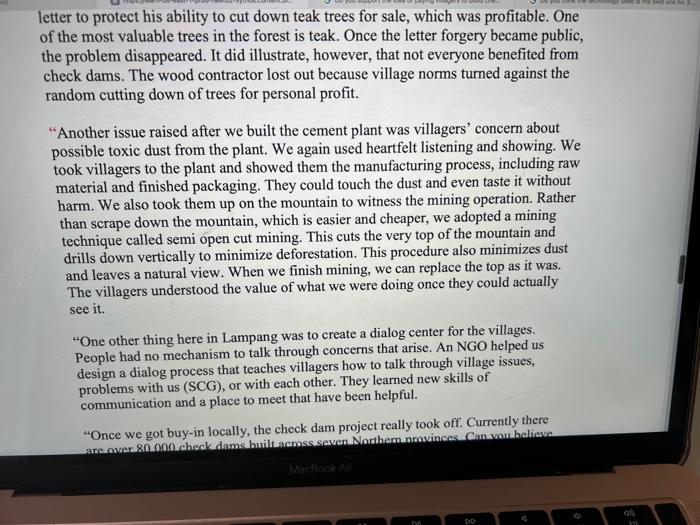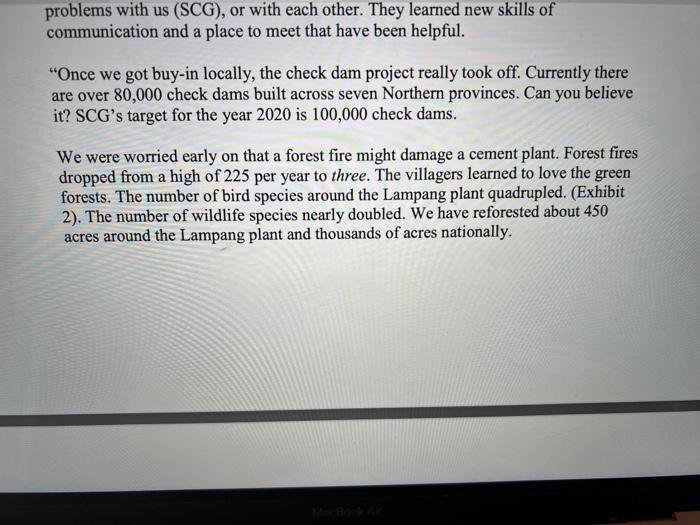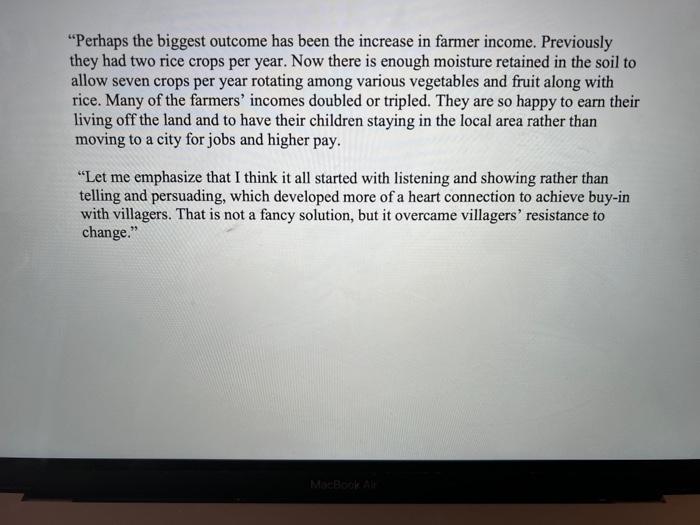URGENT NEED BY 11pm EST
PLEASE DO NOT COPY AND PASTE FROM OTHER CHEGG POST.
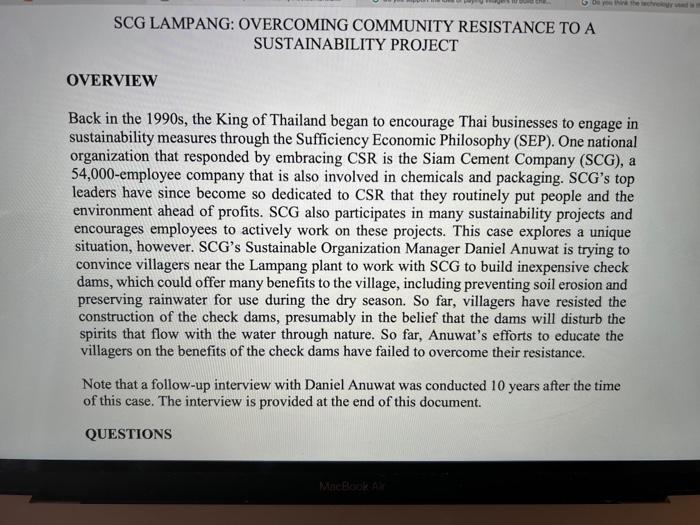
SUSTAINABILITY PROJECT OVERVIEW Back in the 1990s, the King of Thailand began to encourage Thai businesses to engage in sustainability measures through the Sufficiency Economic Philosophy (SEP). One national organization that responded by embracing CSR is the Siam Cement Company (SCG), a 54,000 -employee company that is also involved in chemicals and packaging. SCG's top leaders have since become so dedicated to CSR that they routinely put people and the environment ahead of profits. SCG also participates in many sustainability projects and encourages employees to actively work on these projects. This case explores a unique situation, however. SCG's Sustainable Organization Manager Daniel Anuwat is trying to convince villagers near the Lampang plant to work with SCG to build inexpensive check dams, which could offer many benefits to the village, including preventing soil erosion and preserving rainwater for use during the dry season. So far, villagers have resisted the construction of the check dams, presumably in the belief that the dams will disturb the spirits that flow with the water through nature. So far, Anuwat's efforts to educate the villagers on the benefits of the check dams have failed to overcome their resistance. Note that a follow-up interview with Daniel Anuwat was conducted 10 years after the time of this case. The interview is provided at the end of this document. QUESTIONS villagers on the benefits of the check dams have failed to overcome their resistance. Note that a follow-up interview with Daniel Anuwat was conducted 10 years after the time of this case. The interview is provided at the end of this document. QUESTIONS 1. Do you support the idea of paying villagers to build check dams? Why? Support your answer by integrating concepts from Chapter 7. Identify specifically which concept it is that you are integrating. 2. Other than paying villagers, what other approaches should the Lampang managers take to overcome the villagers' resistance to change regarding the check dams? Support your answer by integrating concepts from Chapter 7. Identify specifically which concept it is that you are integrating. 3. How did SCG implement a corporate culture that strongly supports CSR and sustainability? Does this approach align with what is discussed in chapter 7? 4. How do you think a national sufficiency economic philosophy might have affected SCG's approach to sustainability? Explain and integrate the following interview in your answer. CG Lampang: Overcoming Community Resistance to a Sustainability Project (B) A follow-up interview with Daniel Anuwat occurred 10 years after SCG Lampang's efforts to overcome resistance and gain village buy-in to the idea of check dams and green spaces around the Lampang cement plant. Anuwat is now the community relations manager for the Cement-Building Materials Division. Daniel Anuwat's description of what happened: "We did finally learn how to engage the villagers in our check dam project for reforestation. Then the project hit a tipping point and buy-in really took off. Some cement plants borrowed our model for gaining community engagement to build check dams. The reforestation around the Lampang cement plant is now complete (see photos in Exhibit 1). Exhibit 1 Area around Lampang Cement Plant Before and After Check Dams "First, we decided not to pay money for building check dams. This would make SCG the owner of the project and leave villagers disengaged. It was important that they "First, we decided not to pay money for building check dams. This would make SCG the owner of the project and leave villagers disengaged. It was important that they feel ownership and maintain upkeep of the check dams, so their work must be voluntary. I recall from business school the story of the shopkeeper and the children. The children played noisily outside the window of his room in the rear of his shop. He asked them to play elsewhere, and they refused. He had an idea. He paid the children $0.25 each day to play outside his window. After a few days, he refused to pay them again, so they refused to play there. By paying them, he gained ownership over their behavior. By contrast, we wanted the villagers to feel ownership for the check dams. "How did we get the villagers engaged? We realized that we were being logical and trying to persuade with our heads, and villagers connect with their hearts. Therefore, we stopped talking at them and started listening. Gradually, they started to express their concerns and fears. Our heartfelt listening may have created the biggest change in their attitudes toward SCG and the check dam project. "Another big change was to show them rather than try to tell them everything in words. We took a few key villagers to see the early experimental check dams built by the King. The villagers could actually "see the water." They could see the green forest. They could see the potential. Once we stopped talking and started listening and showing, villager buy-in took hold. "We also addressed specific issues. In the village with fear over the dams restricting spirit flow, we worked with the monk from the local temple. He explained to villagers how spirits would flow with the water into the soil and up through plants and trees. The villagers understood. "We did not get to the bottom of the gunshot incident concerning the monk headman. It may have been a misunderstanding. Alternatively, perhaps the individual with the gun was mortified and withdrew his objection. "With respect to the NG0 letter demanding that we cease reforestation, we made some inquiries and discovered the letter was fake. A teak wood contractor forged the letter to protect his ability to cut down teak trees for sale, which was profitable. One letter to protect his ability to cut down teak trees for sale, which was profitable. One of the most valuable trees in the forest is teak. Once the letter forgery became public, the problem disappeared. It did illustrate, however, that not everyone benefited from check dams. The wood contractor lost out because village norms turned against the random cutting down of trees for personal profit. "Another issue raised after we built the cement plant was villagers' concern about possible toxic dust from the plant. We again used heartfelt listening and showing. We took villagers to the plant and showed them the manufacturing process, including raw material and finished packaging. They could touch the dust and even taste it without harm. We also took them up on the mountain to witness the mining operation. Rather than scrape down the mountain, which is easier and cheaper, we adopted a mining technique called semi open cut mining. This cuts the very top of the mountain and drills down vertically to minimize deforestation. This procedure also minimizes dust and leaves a natural view. When we finish mining, we can replace the top as it was. The villagers understood the value of what we were doing once they could actually see it. "One other thing here in Lampang was to create a dialog center for the villages. People had no mechanism to talk through concerns that arise. An NGO helped us design a dialog process that teaches villagers how to talk through village issues, problems with us (SCG), or with each other. They learned new skills of communication and a place to meet that have been helpful. "Once we got buy-in locally, the check dam project really took off. Currently there are over 80.000 check_dams built across_seven.Northern novinces Can.wou believe problems with us (SCG), or with each other. They learned new skills of communication and a place to meet that have been helpful. "Once we got buy-in locally, the check dam project really took off. Currently there are over 80,000 check dams built across seven Northern provinces. Can you believe it? SCG's target for the year 2020 is 100,000 check dams. We were worried early on that a forest fire might damage a cement plant. Forest fires dropped from a high of 225 per year to three. The villagers learned to love the green forests. The number of bird species around the Lampang plant quadrupled. (Exhibit 2). The number of wildlife species nearly doubled. We have reforested about 450 acres around the Lampang plant and thousands of acres nationally. Exhibit 2 Resurgence of Bird and Animal Species around the Lampang Plant Bindivareitu af Rixd Cnanioe naom tha Camant Dlont Biodiversity of Wildlife near the Cement Plant "Perhaps the biggest outcome has been the increase in farmer income. Previously they had two rice crops per year. Now there is enough moisture retained in the soil to allow seven crops per year rotating among various vegetables and fruit along with rice. Many of the farmers' incomes doubled or tripled. They are so happy to earn their "Perhaps the biggest outcome has been the increase in farmer income. Previously they had two rice crops per year. Now there is enough moisture retained in the soil to allow seven crops per year rotating among various vegetables and fruit along with rice. Many of the farmers' incomes doubled or tripled. They are so happy to earn their living off the land and to have their children staying in the local area rather than moving to a city for jobs and higher pay. "Let me emphasize that I think it all started with listening and showing rather than telling and persuading, which developed more of a heart connection to achieve buy-in with villagers. That is not a fancy solution, but it overcame villagers' resistance to change


